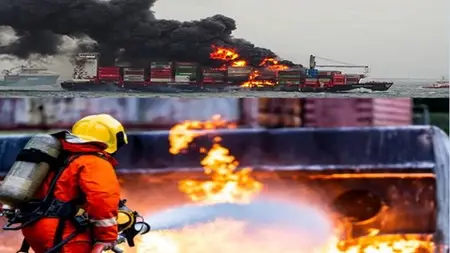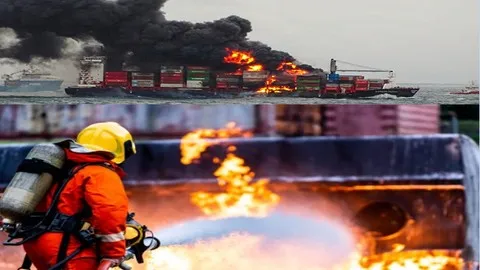Basic Fire Prevention And Fire Fighting Onboard Ships
Published 9/2024
MP4 | Video: h264, 1920x1080 | Audio: AAC, 44.1 KHz
Language: English | Size: 1.87 GB | Duration: 3h 46m
Published 9/2024
MP4 | Video: h264, 1920x1080 | Audio: AAC, 44.1 KHz
Language: English | Size: 1.87 GB | Duration: 3h 46m
Fire Prevention Fire Detection and Fire Extinction
What you'll learn
Learn a minimum standard of competence in fire prevention and fire fighting onboard a ship
A trainee will be competent to take appropriate measures for the fire safety onboard a ship
Protect the safety of peronnal and of the ship from a possible fire onboard
To use fire appliances correctly and also to have a knowledge of fire prevention onboard a ship
Requirements
Physically fit to do the practical fire drills ( mock drills as well as actual drills)
To have a basic English knowledge
Description
Fire is one of the most dangerous enemies in this world. Fire has destroyed valuable lives of people, millions of Dollars worth property and caused serious impact on the environment. Whether it is on dry land, at sea or up in the air the situation is disastrous. Most fires take place due to carelessness of people, bad house keeping and bad maintenance. Fire is a good slave but a bad enemy. Therefore it is of utmost importance to study and have some basic knowledge about what is Fire, How does a fire start, Fire triangle, Fire Detection, Fire alarms, Fire Prevention measures and Fire fighting onboard a ship. In the recent past more container ships carrying dangerous cargo had fires onboard. On 20 May 2021, chemical fume emissions erupted on the Singapore-flagged MV X-Press Pearl containership as it anchored around 9 nautical miles (17 kilometres) northwest of the Port of Colombo in Sri Lanka national waters. An unknown number of containers, some of which carrying dangerous chemicals and plastic pellets, reportedly fell overboard as an intense fire broke out and explosions occurred on 25 May. Once the fire was under control around a week later, an effort to tow the vessel on 2 June to a deeper water refuge failed and resulted in partial sinking of the vessel. By 17 June the entire vessel had settled on the seabed at a depth of about 21 meters. MV X-Press Pearl became a total loss. But the crew were evacuated. There were key issues with regards to the pollution of the marine environment. They were oil pollution, chemical pollution, risks arising from the shipwreck and lost containers, plastic pollution, environmental damage, Impacts on wildlife, Impacts on fisheries industries of the country, Air pollution. The economical loss to the coutry was huge. The tourism industry was very badly hit. Fish exports were stopped. Local fisherman lost their jobs and livelyhood. Furthermore fish consumption dropped to zero levels as they contaminated with chemicals.There were so many incidents involving fire onboard container ships and modern day car carriers. While the shipping industry has modern ships carrying thousands of containers with various types of cargo, ships carrying cars are equally vulnerable.However ships crew members must be trained to Prevent fires, Detect fires and Fight fires with all available fire fighting equipment onboard.
Overview
Section 1: Introduction
Lecture 1 Introduction : Basic Fire Prevention and Fire Fighting onboard ships
Lecture 2 Lecture 1: Conditions for fire
Lecture 3 Lecture 2 : Properties of Flammable Materials
Lecture 4 Lecture 3 : Fire Prevention Principles
Lecture 5 Lecture 4 : Spread of Fire
Lecture 6 Lecture 5 : Safe practices to reduce the fire hazards onboard ships
Lecture 7 Lecture 6 : Need for constant vigilance
Lecture 8 Lecture 7 : Fire Patrol system
Lecture 9 Lecture 8 : Fire hazards
Lecture 10 Lecture 9 : General alarm
Lecture 11 Lecture 10 : Fire control plans and muster list
Lecture 12 Lecture 11 : Communications
Lecture 13 Lecture 12 : Personal Safety Procedure
Lecture 14 Lecture 13 : Periodic Shipboard Drills
Lecture 15 Lecture 14 : Ship construction arrangements
Lecture 16 Lecture 15 : Emergency fire pump, Chemical powder application, Emergency escape
Lecture 17 Lecture 16 : Fire spread in different parts of a ship
Lecture 18 Lecture 17: Ships automatic alarm systems (fire and smoke detection systems)
Lecture 19 Lecture 18 : Types of fire detectors used onboard ships
Lecture 20 Lecture 19 : The automatic sprinkler system
Lecture 21 Lecture 20 : Classification of fire
Lecture 22 Lecture 21: Suitable extinguishing agents for different fire classes
Lecture 23 Lecture 22 : Fire hoses and nozzles
Lecture 24 Lecture 23 : Fire extinguishers hydro testing
Lecture 25 Lecture 24 : Mobile apparatus
Lecture 26 Lecture 25 : Portable fire extinguishers
Lecture 27 Lecture 26: Fireman’s outfit
Lecture 28 Lecture 27: Fire Blankets
Lecture 29 Lecture 28: Knowledge of fire safety arrangements
Lecture 30 Lecture 29: Fire alarms and first actions
Lecture 31 Lecture 30: Firefighting mediums
Lecture 32 Lecture 31 : Fire – fighting procedures
Lecture 33 Lecture 32: Fire fighting ( small fires)
Lecture 34 Lecture 33: How to extinguish a fire using hose
Lecture 35 Lecture 34 : How to extinguish a fire using foam nozzle
Lecture 36 Lecture 35 : How to extinguish extensive fires
Lecture 37 Lecture 36 : Gas fire fighting video clip
Lecture 38 Lecture 37: MCQ Assessment
Lecture 39 Lecture 38: MCQ Answer Script
It is mandatory for anyone who plans a career at sea, prior to starting a sea career,Mandatory for experienced sea farers to refresh their knowledge every 5 years,Anyone who would like to learn about the Fire Prevention masures onboard a ship and Fire Fighting methods,Anyone who would like to learn about various types of fire fighting equipment carried onboard a ship



